| Abt. 1873, at Ashbourne, Derbyshire. Son of Joseph Mansfield Bull & Eliza Ann Leason & Joseph Bull. | |
| Sarah Ellen Salt, 27 July 1897, at St Oswald's Church, Ashbourne, Derbyshire. | |
| Nine identified children, two unidentified children. | |
| Derbyshire, England (Back Lane (now Union Street), Ashbourne, Union Street (now Belle Vue Road)) | Queensland, Australia (Beatrice Street, Brisbane) | |
| Arrived in Brisbane, Queensland, Australia on 10 October 1911. | |
| Scholar | Grocers Porter | Labourer | Railway Brakeman | Railway Guard | Stoker | |
| 4 December 1914, at West End Gasworks, West End, Brisbane, Queensland. Aged 41 years. | |
| Medium confidence: Multiple birth, census, marriage, and death records confirm parental relationship. Census, military, and immigration records, as well as newspaper articles, confirm occupation and relationships. Changes in occupation and residential location are reasonable and well documented. |
| Ancestry Profile | |
| FamilySearch Profile | |
Charles William Bull (1907-1979) |
1906
aged 33 years
Joseph Bull died 1906. Aged 85 years.
1 September 1907
aged 34 years
Eliza Ann Leason died 1 September 1907, at Union Street, Ashbourne, Derbyshire. Aged 54 years.
Birth and Childhood
George was born on 17th January 1873, at King Street in Ashbourne, Derbyshire [Figure 1]. He was the third child and eldest son of Joseph Mansfield Bull and Eliza Ann Leason. George was baptised at St Oswald’s Church in Ashbourne, with his older sister, Sarah Ann, on 12th February 1873 [Figure 2].

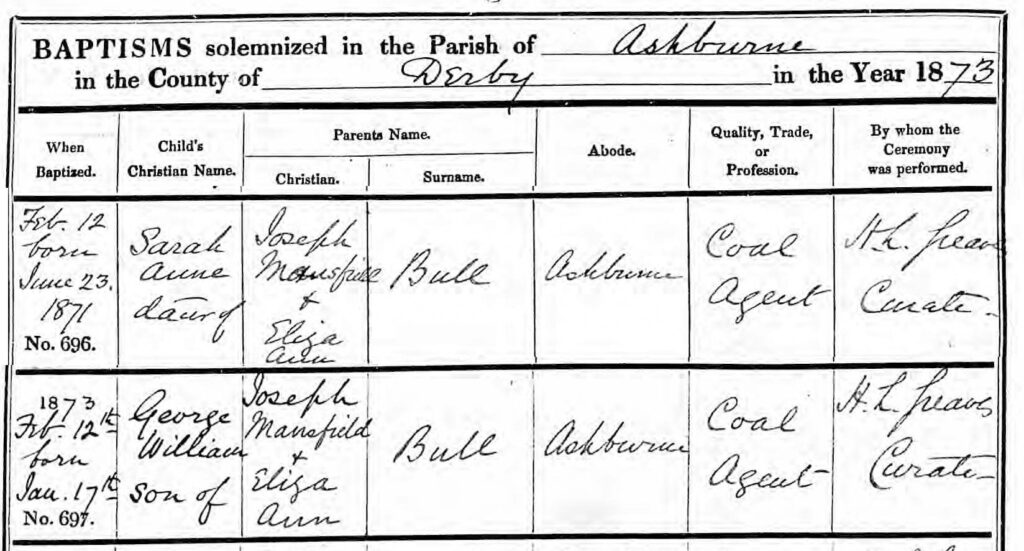
At the time of the 1881 Census, George was living with his parents and three surviving siblings, Sarah Anne Bull, Thomas Charles Bull, and Hannah Eliza Bull, in Back Lane, Ashbourne [Figure 3]. George and his siblings Sarah and Thomas were listed as Scholars, an education later evidenced by the ability to sign his name on his marriage registration [Figure 5].

In 1891, the family had moved to Adin’s Yard in Ashbourne, where George lived with his parents and seven surviving siblings [Figure 4]. George was now eighteen years old and worked as a Grocer’s Porter.
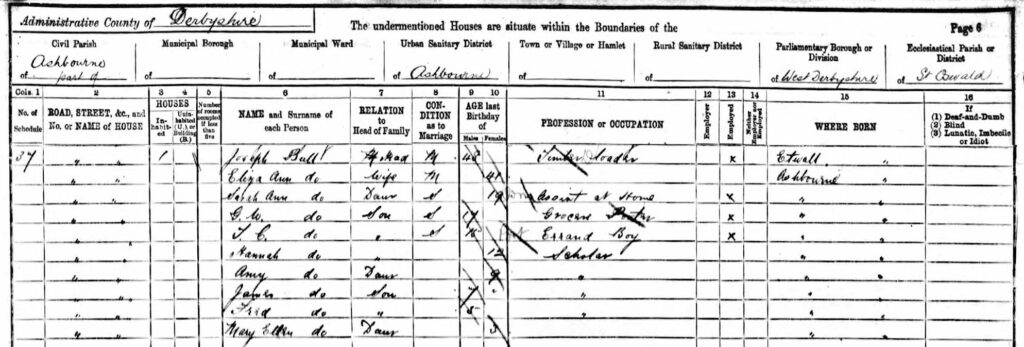
Marriage
On 27th July 1897, at St Oswald’s Church in Ashbourne, George married Sarah Ellen Salt [Figure 5]. His age was incorrectly shown as 26 years, as he was only 24 years old at the time. The marriage was witnessed by George’s sister, Hannah Eliza Bull.

Following their marriage, George and Sarah moved to Union Street in Ashbourne, where they continued to reside until they emigrated to Australia in 1911. On 29th May 1898, Sarah gave birth to their first daughter, Florence Annie Bull, who sadly died 9 months later in March 1899.
Military Service
Between 1899 and 1901, George left England to fight in the Boer War as a part of the Mafeking Railway Volunteers, initially as a Private but later being promoted to a Corporal [Figure 7]. Also known as the Railway Division, they took an active role in the Defence of Mafeking, constructing shell-proof trenches, building armoured rail bogies, and even casting cannonballs and shells [8].

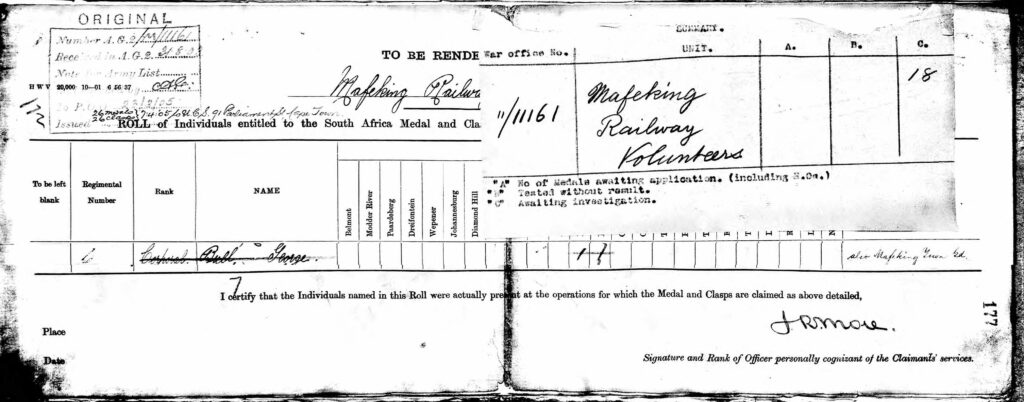
While George was abroad, his wife Sarah gave birth to their second child, Eileen Marjorie Bull, in July 1900. She was staying with her parents in Marchington, Staffordshire at the time. Following his return from the war, George and Sarah had two more children, Gladys Lillian Bull in September 1902, and Francis George Bull in October 1904.
Court Appearances
![1906 06 15 curious assault case [ashbourne telegraph]](https://family.timothydeparis.com/wp-content/uploads/articles/1906-06-15-Curious-Assault-Case-Ashbourne-Telegraph-700x1024.png)
On the evening of 3rd June 1906, George was walking to visit his mother. While walking, he passed Robert Cundy [10], a labourer also residing in Union Street. Robert “put his arms around [George’s] neck and bit him on the cheek”. George struck back in self-defence. A tussle followed, at which point the police attended.
The matter was brought before Peveril Turnbull, Esq. [11] at the Ashbourne Petty Sessions the following Saturday. Robert claimed he was struck first, however after hearing all the evidence, the court found him guilty of “an unprovoked assault in a brutal and unmanly fashion”. Robert was fined 10s. and required to pay 12s. 6d. court costs. However, as he was unable to pay, he instead served a one-month jail sentence with hard labour.
On 7th February 1907, George’s fifth child, Charles William Bull, was born at Union Street in Ashbourne.
Shortly after Charles’ birth, on 22nd April 1907, George was charged “with stealing one bag of potatoes, value 5s, from the [Ashbourne] railway station”, where he worked as a Brakeman [Figure 9]. Although he initially denied the charge, stating that he had bought the potatoes from someone at Macclesfield, the evidence against him was overwhelming and he ultimately admitted his guilt.
George pleaded for leniency, stating:
I am very sorry; it is the first time I have been brought before a Court. I hope therefore you will deal leniently with me.
The Chairman was sympathetic to his plea, and he was spared jail as this was his “first time… brought before a Court”, and he was “a respectable and hard-working man” of “good character from the Army”.
George was fined 10s., with court costs of £3 6s. (about six months wages for an agricultural labourer [12], although as a railway brakeman George would have earned a higher wage). He was granted two months to pay the money. Although he escaped prison, it appears that the incident resulted in George losing his job with the railway company as in future records his occupation is listed as a Labourer.
![1907 05 10 stealing potatoes from the railway station [ashbourne news telegraph]](https://family.timothydeparis.com/wp-content/uploads/articles/1907-05-10-Stealing-Potatoes-from-the-Railway-Station-Ashbourne-News-Telegraph-1024x781.jpg)
At the time of the 1911 Census, George was living at 12 Union Street, Ashbourne, with his wife Sarah and children Eileen, Gladys, Francis, Charles, and Dorothy [Figure 10]. They were living in a house with three rooms, including the kitchen, and George was working as a Bricklayer’s Labourer. A few weeks after the census, on 19th April 1911, Sarah gave birth to their eighth child, Wilfred Thomas Bull.
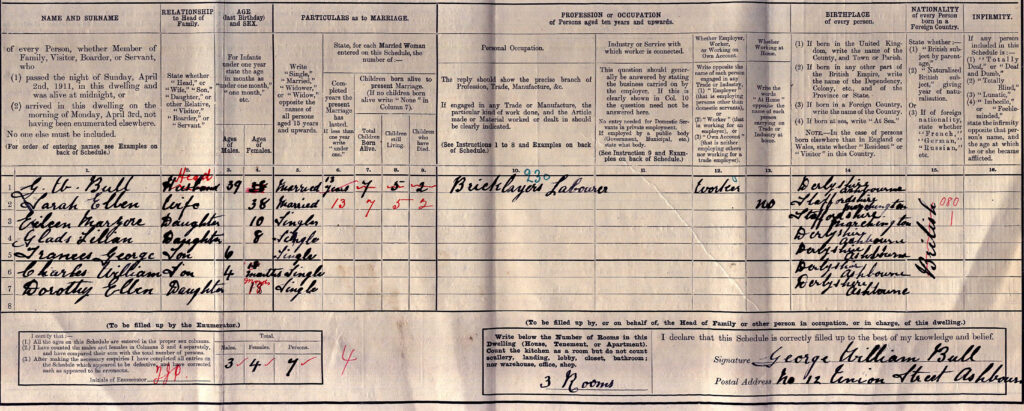
Immigration
On 21st August 1911, George, Sarah and their six children, Eileen, Gladys, Francis (“Frank”), Charles, Dorothy (“Nellie”) and Wilfred, set sail for Australia on board the S.S. Torilla [Figure 12]. They travelled as nominated passengers; however, no records have been found yet regarding their nomination. The voyage took 50 days, arriving in Brisbane on 10th October 1911. The vessel brought 1,589 passengers to Queensland, stopping to drop off passengers as they sailed down the East coast of Australia.


By 1913, the family were living on the Jubilee Estate in Paddington, Brisbane [Figure 13]. George and Sarah had three more children after they arrived in Australia, however they all died as infants.

Death
On 4th December 1914, George died of heart failure, more specifically atheroma of the coronary arteries, while working as a Stoker at the West End Gasworks [Figure 14]. The news made it back to his hometown of Ashbourne [Figure 16], where it was reported he had “remarked to a fellow-workman that he would go outside and get a little fresh air. He sat down, and expired almost immediately.” He was 42 years old.
George’s death certificate shows that as well as his living children, he was the father of three deceased daughters and a deceased son (his youngest son, Eric, had not yet been born). This reveals that another currently unidentified child was born between the 1911 Census and the time of his death.
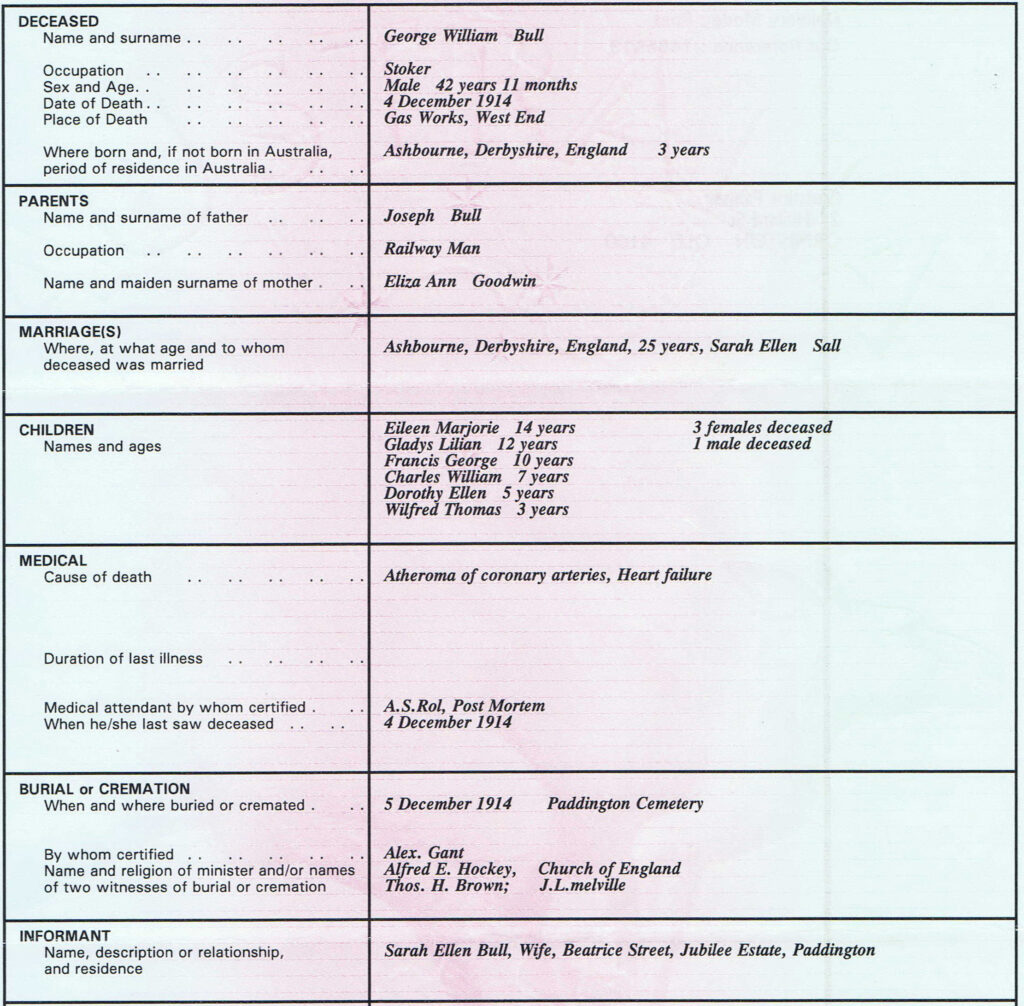
![1914 12 05 a sudden death [the brisbane courier]](https://family.timothydeparis.com/wp-content/uploads/articles/1914-12-05-A-Sudden-Death-The-Brisbane-Courier.jpg)
![1915 02 05 sudden death of an ashbournian in australia [ashbourne news telegraph]](https://family.timothydeparis.com/wp-content/uploads/articles/1915-02-05-Sudden-Death-of-an-Ashbournian-in-Australia-Ashbourne-News-Telegraph.jpg)
George’s death certificate shows he was buried at Paddington Cemetery in Brisbane. However, this seems unlikely as Paddington Cemetery was closed around 1875, and by 1914 most memorials and remains had been relocated to other cemeteries [13]. Additionally, George’s name is absent from the list remains and memorials relocated from the cemetery [14].
George’s final resting place can be found in the Toowong Cemetery in Brisbane, where he is buried with his wife Sarah, and infant children Rita and Eric [Figure 17].
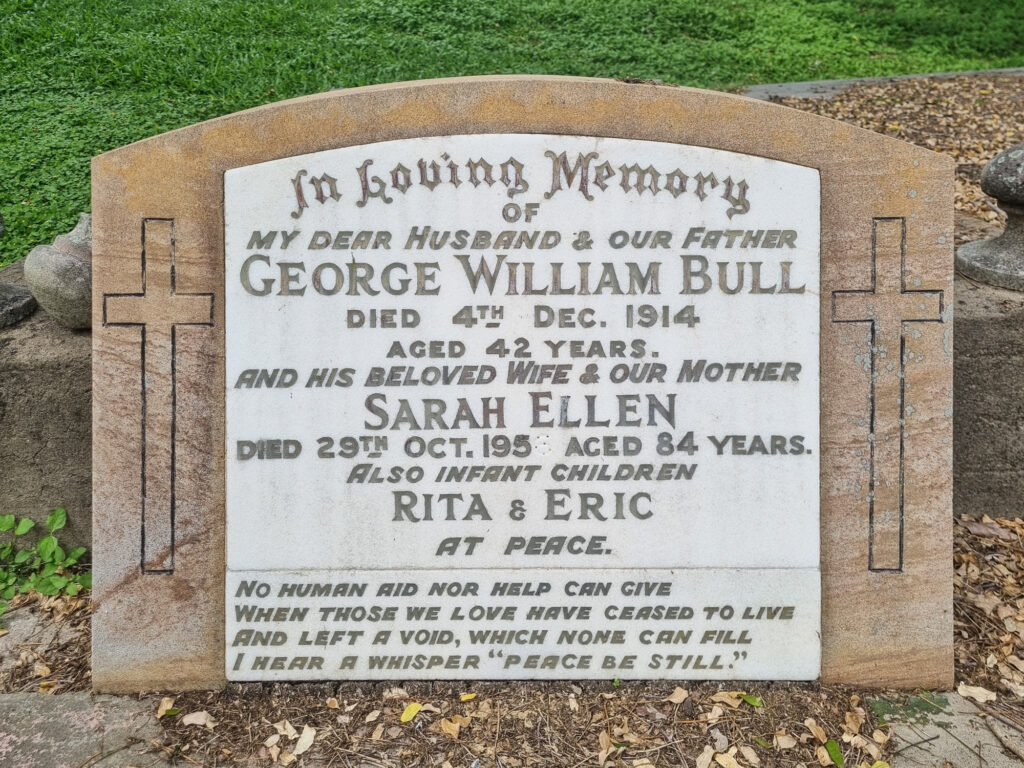
Additional Records
- "Wedding", Ashbourne Telegraph, 3 March 1905 - On Monday, the marriage was solemnized at Ashbourne Parish Church of Mr. William Johnson, of the ASHROURNE TELEGRAPH staff, and Miss Amy Elizabeth Bull, third daughter of Mr. J. Bull, of Union-street. The bridesmaids were Miss M. E. Bull and Miss S. A. Tatlow. The bride, who was prettily attired in a costume of navy…
- "A Dispute and an Assault", Derbyshire Advertiser and Jornal, 15 June 1906 - Robert Cundy, labourer, of Union-street, Ashbourn, was summoned by George William Bull, of the same street, for assaulting him on the 3rd inst.—Complainant alleged that defendant came up behind him, put his arm around his neck, and bit his cheek. Complainant struck him in self-defence, and in the tussle which ensued both men fell to…
- Birth, Charles William Bull, 21 March 1907 - Registration District AshbourneSub-District Ashbourne 1907. BIRTHS in the Sub-District of Ashbourne in the County of Derby No. 254 When and Where Born. Seventh February 1907Union Street Ashbourne U.D. Name, if any. Charles William Sex. Boy Name and Surname of Father. George William Bull Name and Maiden Surname of Mother. Sarah Ellen Bull formerly Salt Rank…
- "Serious Charge Against a Railway Guard", Ashbourne Telegraph, 3 May 1907 - POLICE STATION.—Friday. Before Mr. James Osborne, J.P. George Bull, a goods-guard in employment of the North Stafford Railway Company, and living at Union-street, Ashbourne, was charged with the unlawful possession of a quantity of potatoes, the property of the company. Inspector Arms, of the railway detective department, had charge of the case. Evidence was given…
Research Opportunities
- Employment Records for Joseph Mansfield Bull & George William Bull - The National Archives in London may hold employment records from the North Staffordshire Railway Company (Collection: RAIL 532)
- Military Service of George William Bull - The National Archives in London may hold military service records for the Mafeking Railway Volunteers in South Africa.
Completed Research
- Unidentified children of George William Bull & Sarah Ellen Salt - Some records for George William Bull reveal the existence of two deceased children for which it has not yet been possible to locate any confirmatory records. The first is revealed in the 1911 Census return, where George lists seven children, two of whom have died . Up until the date of the Census (2nd April…
Research Statement
The following table provides confidence levels for individual aspects of the research undertaken. Note that these confidence levels do not take into account contextual information and only apply to the evidence gathered for the individual fact. A wholistic confidence level for the ancestor can be found in the Key Facts table at the top of the page.
Sources
Sources for historical records included in this page are not listed for brevity. They can be found by clicking through to the individual records, or by visiting the Ancestry or FamilySearch profiles linked at the top of this page.
[1] Mafeking Railway Volunteers. (2022, August 31). Retrieved from Anglo Boer War: https://www.angloboerwar.com/unit-information/south-african-units/2582-mafekingrv
[2] Mafeking, South Africa, c. 1900, The Railway Division of the Town Guard on Parade in the Market Square. (2022, August 31). Retrieved from Australian War Memorial: https://www.awm.gov.au/collection/C49492
[3] Robert Cundy (1874-Deceased). (2022, September 1). Retrieved from FamilySearch: https://www.familysearch.org/tree/person/details/GHDP-Z9H
[4] Peverill Turnbull (1850-1926). (2022, September 1). Retrieved from FamilySearch: https://www.familysearch.org/tree/person/details/MGK8-9YS
[5] Agricultural labourers' wages - 1850-1914. (2022, September 2). Retrieved from Wages Through History: https://historyofwages.blogspot.com/2011/02/agricultural-labourers-wages-1850-1914.html
[6] Paddington Cemetery. (2022, September 2). Retrieved from Brisbane City Council: https://www.brisbane.qld.gov.au/community-and-safety/community-support/cemeteries/historic-cemeteries/paddington-cemetery
[7] List of remains and memorials removed to the Brisbane General Cemetery (Toowong). (2022, September 2). Retrieved from Brisbane City Council: https://www.brisbane.qld.gov.au/sites/default/files/Cemeteries_Visiting_our_Cemeteries_List_of_remains_and_memorials_removed_to_the_Brisbane_General_Cemetery_%28Toowong%29.pdf
[8] Mafeking Railway Volunteers. (2022, August 31). Retrieved from Anglo Boer War: https://www.angloboerwar.com/unit-information/south-african-units/2582-mafekingrv
[9] Mafeking, South Africa, c. 1900, The Railway Division of the Town Guard on Parade in the Market Square. (2022, August 31). Retrieved from Australian War Memorial: https://www.awm.gov.au/collection/C49492
[10] Robert Cundy (1874-Deceased). (2022, September 1). Retrieved from FamilySearch: https://www.familysearch.org/tree/person/details/GHDP-Z9H
[11] Peverill Turnbull (1850-1926). (2022, September 1). Retrieved from FamilySearch: https://www.familysearch.org/tree/person/details/MGK8-9YS
[12] Agricultural labourers' wages - 1850-1914. (2022, September 2). Retrieved from Wages Through History: https://historyofwages.blogspot.com/2011/02/agricultural-labourers-wages-1850-1914.html
[13] Paddington Cemetery. (2022, September 2). Retrieved from Brisbane City Council: https://www.brisbane.qld.gov.au/community-and-safety/community-support/cemeteries/historic-cemeteries/paddington-cemetery
[14] List of remains and memorials removed to the Brisbane General Cemetery (Toowong). (2022, September 2). Retrieved from Brisbane City Council: https://www.brisbane.qld.gov.au/sites/default/files/Cemeteries_Visiting_our_Cemeteries_List_of_remains_and_memorials_removed_to_the_Brisbane_General_Cemetery_%28Toowong%29.pdf
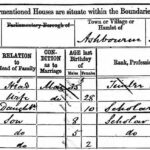

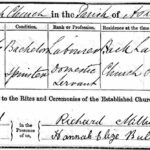
![1906 06 15 curious assault case [ashbourne telegraph]](https://family.timothydeparis.com/wp-content/uploads/articles/1906-06-15-Curious-Assault-Case-Ashbourne-Telegraph-150x150.png)
![1907 05 10 stealing potatoes from the railway station [ashbourne news telegraph]](https://family.timothydeparis.com/wp-content/uploads/articles/1907-05-10-Stealing-Potatoes-from-the-Railway-Station-Ashbourne-News-Telegraph-150x150.jpg)
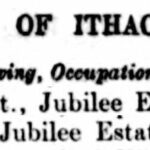

![1914 12 05 a sudden death [the brisbane courier]](https://family.timothydeparis.com/wp-content/uploads/articles/1914-12-05-A-Sudden-Death-The-Brisbane-Courier-150x150.jpg)